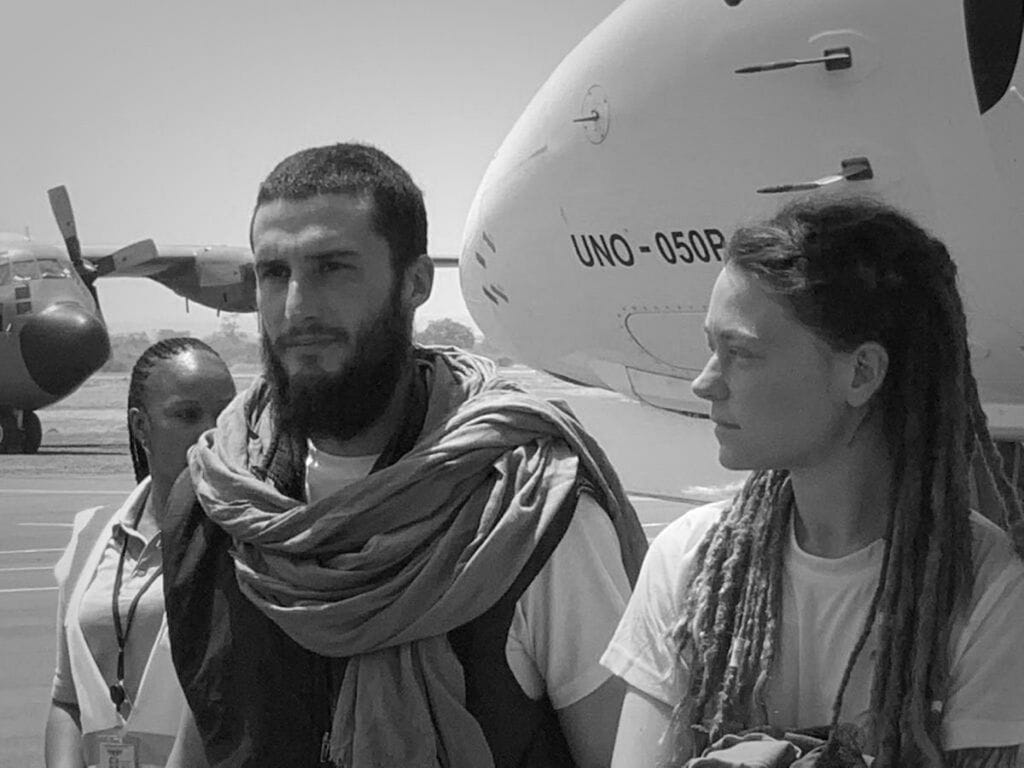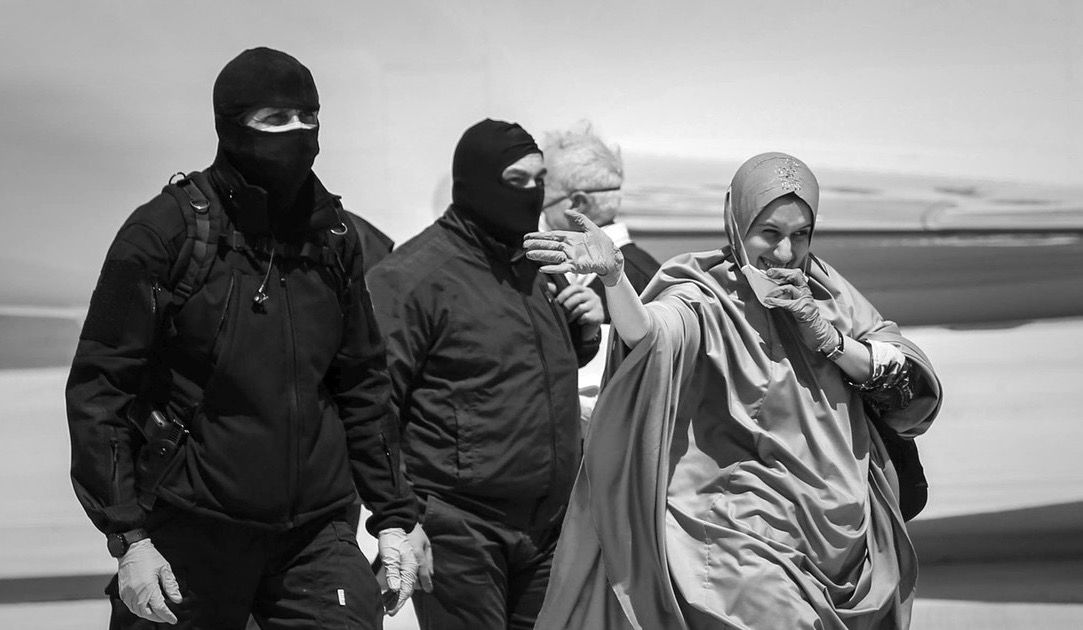News of Silvia Romano’s liberation started to circulate in social media on May 9th. Each one of our virtual walls, irrespective of the political faction, cultural background and personal beliefs exuded joy, happiness and commotion. After 545 days in the hands of Harakat al-Shabaab al-Mujahidin, a Somali-based Islamist militant group with links to al-Qaeda, Silvia Romano, a 25 years old NGO worker from Milan was liberated. The day after, she landed in Rome where the highest officials of the State put up a savior show, and she could finally break up in tears in her mother’s arms.
But something didn’t add up. In the warm welcome home, there was a disturbing element in the bystanders’ eyes. She was wearing a hijab. Everyone remembered her from her pictures in the field in Kenya wearing colorful t-shirts, braids and shorts. It couldn’t be. There must be an error. Maybe she was obliged to wear it during the trip and then she will go back to be a gender-conforming woman wearing clothes that are considered as “normal”. And then, the horror. She declared to have converted to Islam voluntarily.
The following day, two right-wing Italian newspapers wrote an indelible mark in journalism. “We freed a Muslim”, “Islamic and happy, the ungrateful Silvia” were the titles in the front pages. Quickly the narrative that Italian authorities used taxpayers’ money to repatriate a jihadist started to spread in social media. Suddenly we were back to September 12th, 2001, as if almost two decades of efforts in deconstructing the equivalence of Muslims with terrorists in the public debate did not exist.
Soon after she was kidnapped, back in 2018, Silvia was insulted because she was working in a remote and dangerous context and that by doing that, somehow, she brought the kidnapping on herself. Then she was insulted because instead of focusing on the Italians in need, she went abroad to help Kenyan children. After regaining freedom, she was insulted because her liberation allegedly cost a few million euros; then she was insulted because she was wearing a hijab; then she was insulted because she became Muslim; then she was insulted because she was smiling. She was the victim of the so-called keyboard warriors, those who feel legitimized to post hate messages online, hidden by false identities, who even though they are a minority, have their abusing discourses amplified by the digital echo chamber. In the meantime, the Public Prosecutor’s office has opened an investigation on the threats against her.
Talking with the anti-terrorism unit, she gave an empathetic account of her captivity that once again is framed as an anomaly. According to media reports, she recalls that “the first days were hard and then she kept strong, finding inner balance”. Her captors never exerted physical, sexual or psychological violence on her and were reassuring her on the fact that sooner or later she would be freed. She changed six different locations where she was kept in isolation. These revelations which are part of a criminal investigation and thus should be secret, have been reported by the media, while Silvia or her family did not issue any official statement or declaration besides saying “I am doing well” upon her arrival. The Italian media contributed to create a blame-the-victim narrative which is frequently directed at kidnapped NGOs’ workers. Immediately, police officers declared that it seemed a textbook case of Stockholm syndrome as Silvia, or Aisha - as she now wishes to be called -, developed an emotional bond with her captors. These feelings are usually considered as irrational in light of the perilous conditions and psychological stress endured by the hostage. This must be it, then. She must be in shock and suffer from psychological trauma. It just can’t be that she decided to willingly embrace a different faith, in a world where supposedly there is freedom of religion.

In March 2020, another Italian hostage, Luca Tacchetto, was liberated together with his partner Edith Blais, after 15 months of captivity between the center and North of Mali. He reported being well treated and never threatened with guns and that he had converted to Islam as well, and upon his arrival he was wearing “exotic” clothing. Nobody suggested that he suffered from psychological dysfunctionalities or was in a delusional and negationist state of mind. But the same line of thought doesn’t apply to a woman, framed as inherently fragile and submissive. She couldn’t make her own mind, in all those months spent in solitude, writing a notebook and reading the Qur'an. It cannot be her free choice to worship whatever God she wants. She must have been tricked into it, as women have no agency of their own.
Two other Italian citizens were liberated during the last year: Alessandro Sandrini and Sergio Zanotti captured by Al Qaeda on different occasions in Syria and released after negotiations with Italian authorities. Alessandro Sandrini had also converted to Islam. And again, no one asked for his prosecution for engaging in terrorist activities nor made sexual remarks or commented on his appearances, as it happened in Silvia’s case. In the past days, some even recalled the images of the sentencing of Fabrizio Quattrocchi, an Italian mercenary kidnapped in Iraq in 2004 whose last words were “I’ll show you how an Italian dies”, while looking directly in their murderers’ eyes before being shot. The rightist parties Alleanza Nazionale and Forza Italia promoted the narrative that he was a hero who died proudly for his country. He was posthumously honored by the Italian president Carlo Azeglio Ciampi with the Gold Medal for Civil Valor, an honor that Enzo Baldoni, an Italian journalist kidnapped and killed in Iraq in the same year did not deserve. Enzo Baldoni, like Silvia, was a pacifist who was volunteering for the Red Cross. The discourse invites a broader reflection on the belittling of idealist principles of those who work in the humanitarian sector, and especially in cases when a woman chooses this path, her condemnation is blown out of proportion.
But this kind of gender bias in the Italian public discourse is not new. When Simona Pari and Simona Torretta (“the two Simonas” are they were amicably called) returned to Italy in colorful caftans after five months and a half of captivity in Iraq in 2004, when they declared that they would not stop working in the development sector they were labeled as “two cackling hens”. The mainstream media would have wanted them to get back in modest clothes swearing that they would never dare to go abroad again. Two other volunteers, Greta Ramelli and Vanessa Marzullo, were kidnapped in Syria in 2014 by al-Nusra and liberated after a year held in captivity. In their social media profiles pictures before their abduction, they posted pictures portraying them smiling and wearing “hippie clothes” so the narrative was that “they went to Syria to have fun”. At their arrival, rumors started to spread that they were pregnant, rumors that some media have already started spreading about Silvia as well. When they denied the speculations and said that they were treated well, the insults started again “If you were doing so well, you could have stayed there”.
What do all the “condemned” cases have in common? One simple thing: they are all about women. Women who decided to be independent, who legitimately decided to break the stereotype of male-subordinated figures and refused to conform to traditional gender roles and norms. In this type of male-dominated framing, the special agents who rescued Silvia, and all the other men who fight in wars are heroes, but women who for moral principles decide to make a living helping others abroad (where even Kenya is a dangerous place) are depicted as foolish and unwitting. And if they decide to embrace a different faith, they have been manipulated. These women are inconvenient as they do not fit in the stereotypical phallocentric models that assume only certain behaviors to be legitimate. They are unsettling as they put forward a different model, a liberated woman free to be whatever she chooses to be. But the worse thing is that they are framed, constructed, spoken about, whereas their own voice remains weak, faint, unheard, and when actually heard, it is misheard and misrecognized.
Two aspects that are worth mentioning besides the fact that negotiations and payment for the release of hostages is standard practice, also for national security reasons based on the implicit assumption that if we behave well, there are lesser chances that an attack on our soil would happen. Firstly, there seems to be a broader dynamic of international, national and local politico-military negotiations aimed at conflict resolution. It is the case for example of the dialogue that Ibrahim Boubacar Keïta, the Malian President started with Koufa and Ag Ghali, two supreme leaders of Al-Qaeda affiliated groups in Mali. Rather than suggesting that jihadists are going soft, it suggests that Qaedists affiliates are increasingly looking for legitimization at the international level, and in this sense, al-Shabaab increased its stance. Secondly, in the view of organizations’ financing, hostages are bargaining chips, that clearly loose value if they die. This gave rise to a lot of criticism and reopened the age-old dilemma if states should contribute to the financing of terrorist groups paying ransoms. To add to the confusion, in this dystopian context, the Italian Coordination of associations for the defence of the environment and the protection of consumer rights (Codacons) filed a complaint to the Italian Court of Auditors for the liberation of Silvia as the payment of a ransom to the kidnappers could represent not only a criminal but also an accounting offence.
What happened to Silvia is extremely complex, sensitive, and above all personal. And she will need time to understand what happened to her; the time to cry and finally enjoy her regained freedom, a time that right-wing parties and the (social) media are not granting her. Welcome home Silvia, and let’s hope that Italy will not treat you worse than Al-Shabaab.
Acknowledgements
Cover photo by ANSA (C)

